The US is doubling down on domestic energy production, driven by economic pressures, supply chain disruptions, and a desire for energy independence. This surge in local energy, from oil and gas to renewables, promises to reshape industries, and logistics is no exception. Over the next 12 months, the logistics sector will feel the ripple effects of this energy boom, facing both challenges and opportunities. While increased demand for transportation could strain capacity, the potential for lower fuel costs and infrastructure improvements offers a path to reduced freight expenses. Here’s how companies can navigate this evolving landscape to move freight more efficiently and at lower costs.
Lower Energy Prices:
A Boom for Fuel Costs
One of the most immediate benefits of ramped-up domestic energy production is the potential for lower fuel prices. As the US boosts output of oil, natural gas, and renewables, energy markets could stabilize or even see price declines. Since fuel is a major expense in logistics—accounting for up to 30% of operating costs for some carriers—cheaper energy directly translates to savings.
- Impact on Transportation: Lower diesel and gasoline prices reduce surcharges and overall shipping rates. For example, a 10% drop in fuel costs could shave significant dollars off long-haul trucking expenses.
- Actionable Tip: Lock in fuel surcharges or negotiate fixed-rate contracts with carriers now, before potential price dips. This secures predictable costs and shields against future volatility.
However, companies should remain cautious. Global factors, like geopolitical tensions or OPEC decisions, could still influence prices. Diversifying transportation modes (e.g., rail or intermodal) can hedge against fuel price swings.
Rising Demand for Transportation:
Navigating Capacity Crunch
While lower fuel costs are a tailwind, the energy boom will also drive up demand for logistics services. Moving drilling equipment, pipelines, and renewable components—like wind turbine blades or solar panels—requires specialized transportation. This surge could tighten capacity, especially in trucking and rail, leading to higher rates and potential delays.
- Strain on Trucking: The trucking industry, already grappling with driver shortages, may face further pressure. Flatbed carriers, in particular, could see spiking demand for hauling oversized energy equipment.
- Rail and Ports: Increased shipments of crude oil or liquefied natural gas (LNG) via rail or to export terminals could clog key corridors.
- Actionable Tip: Book capacity early and consider multi-year contracts with carriers to secure space before demand peaks. Explore less-than-truckload (LTL) or intermodal options to bypass trucking bottlenecks.
Companies that anticipate these shifts can avoid last-minute scrambles and negotiate better terms.
Infrastructure Upgrades: Unlocking Efficiency
The push for domestic energy isn’t just about production, it’s about infrastructure. New pipelines, rail lines, and port expansions are on the horizon, promising to streamline freight movement. For instance, the completion of pipelines like the Mountain Valley Pipeline could reduce the need for truck or rail transport of natural gas, freeing up capacity for other goods.
- Improved Rail Networks: Expanded rail infrastructure for energy shipments could enhance overall network efficiency, reducing transit times for non-energy freight.
- Port Modernization: Upgrades to handle LNG exports or renewable component imports could boost container throughput, benefiting all shippers.
- Actionable Tip: Monitor infrastructure projects and adjust routing strategies. For example, reroute shipments through newly upgraded ports or rail hubs to cut transit times and costs.
Hypothetically, companies shipping goods from the Midwest to the East Coast might switch from trucking to rail once new energy-related rail lines open, slashing both time and expense.
Policy Incentives:
Leveraging Government Support
The domestic energy push is backed by policy, with tax breaks, grants, and subsidies aimed at boosting production and efficiency. Logistics companies can tap into these incentives to offset costs.
- Energy-Efficient Upgrades: Grants for carriers to adopt electric or natural gas-powered vehicles could lower operating costs, with savings passed to shippers.
- Renewable Energy Credits: Warehouses or distribution centers that install solar panels might qualify for tax incentives, reducing overhead.
- Actionable Tip: Research available programs, such as the Department of Energy’s grants for clean transportation technologies. Partner with carriers that are investing in these areas to secure preferential rates.
For example, a logistics provider that switches its fleet to compressed natural gas (CNG) trucks could offer lower rates due to reduced fuel expenses and government incentives.
Labor Dynamics:
Adapting to a Shifting Workforce
The energy sector’s growth could exacerbate labor shortages in logistics. As energy companies ramp up hiring, they may draw workers away from transportation, driving up wages and tightening capacity further.
- Driver Shortages: Trucking, already facing a deficit of 80,000 drivers, could see even fewer available workers.
- Warehouse Labor: Distribution centers near energy hubs might struggle to retain staff, increasing operational costs.
- Actionable Tip: Invest in automation—such as warehouse robotics or AI-driven route optimization—to reduce reliance on labor. Offer competitive benefits or partner with third-party logistics (3PL) providers that have strong workforce management.
Companies that proactively address labor challenges will maintain service levels without ballooning costs.
Actionable Strategies to Reduce Freight Costs
To capitalize on the domestic energy boom and mitigate risks, companies should adopt a multi-pronged approach:
- Lock in Contracts Early: Secure transportation agreements before capacity tightens. Consider fixed-rate deals to hedge against rate hikes.
- Diversify Transportation Modes: Use rail, intermodal, or LTL services to avoid trucking bottlenecks. Explore carriers using alternative fuels for potential savings.
- Leverage Infrastructure: Reroute freight through new or upgraded hubs. For instance, a company might shift from the congested Port of Los Angeles to a modernized Gulf Coast port.
- Tap into Incentives: Apply for grants or partner with carriers benefiting from energy-related subsidies. A warehouse powered by solar could cut energy bills by 20%, indirectly lowering logistics costs.
- Invest in Technology: Use AI for demand forecasting and route optimization to minimize empty miles and reduce fuel consumption.
- Relocate Strategically: Consider moving distribution centers closer to energy production hubs where transportation costs may be lower due to abundant local capacity.
For example, a manufacturer might relocate a facility to Texas, where shale oil production keeps local energy and transportation costs low, while also benefiting from proximity to new rail lines.
Going Forward
The domestic energy push will be a double-edged sword for logistics over the next 12 months. While lower fuel prices and infrastructure upgrades offer cost-saving opportunities, rising demand and labor constraints could drive up rates. Companies that act now by securing capacity, leveraging policy incentives, and embracing technology can turn these changes into a competitive advantage. The key is agility: stay informed, diversify options, and invest in efficiency. Those who do will not only weather the storm but emerge with leaner, more resilient supply chains.
At Native American Logistics, we understand the unique challenges and opportunities in today’s energy and transportation landscape. Our team provides tailored logistics solutions to help businesses optimize supply chains, manage costs, and maintain reliability. Ready to streamline your operations and stay ahead of the curve? Contact us today to see how we can support your logistics needs.

Jeff Berlin
is the Chief Operating Officer of E.L. Hollingsworth & Co. and serves as the Senior Operations Executive for TOP Worldwide and Native American Logistics. With over 30 years of experience leading logistics and trucking companies, he brings deep industry expertise to his role. Jeff is also a CDL-A driver and a private pilot. Contact Jeff at jberlin@elhc.net.
 +1 877 781 3006
+1 877 781 3006 (52) 554-870-5682
(52) 554-870-5682




